Basics of EPC Training Introduction Objectives 2 Create

Basics of EPC Training

Introduction Objectives: - 2 Create awareness of the concepts Develop technical knowledge Show benefits of implementation Explain 5 steps of Implementation

Programme • • • 3 Introduction What is EPC? Benefits of the EPC Applications Technical Information Implementation

What is EPC? 4

What is EPC? EPC is one of GS 1 Products 5

What is EPC? GS 1 Solutions: GS 1 TRACEABILITY 6

What is EPC? GS 1 Solutions: Patient Safety & Healthcare 7

The EPC Concepts 8

The EPC Concepts Exchange Capture Identify The Basic Needs of the Supply Chain 9

The EPC Concepts Basic needs: identification 10

The EPC Concepts Basic needs: Data Capture 11

The EPC Concepts Basic needs: Data Exchange 12

The EPC Concepts Solution to the basic needs: 13

The EPC Concepts Solution to identification EPC = Electronic Product Code. The EPC identifies each single item. 14

The EPC Concepts Solution to DATA CAPTURE The EPC, is captured using RFID RADIO FREQUENCY IDENTIFICATION 15

The EPC Concepts Solution to Data Exchange EPC is a System that allows the trading partners to capture and share information about the items in an automated way. EPCglobal Network provides real-time information about each item. 16

EPCGlobal Inc. / Standards • The development process of the standards starts with gathering user requirements. • The standards are then developed based on these user requirements, by technical experts from solution providers. • These will be open standards. 17

Summary This topic presented the three major concepts of identification, data capture and data exchange and how EPCglobal Inc has provided solutions to these key questions: - the Electronic Product Code (EPC) to identify items - RFID to capture information - the EPCglobal Network to exchange data 18

Identification Keys 19

GS 1 Identification Keys Definition • GS 1 Identification Keys provide access to database information relevant to trading partners. Objectives • A single, open, business led, integrated system of identification for effective supply chain management in any company, in any industry, anywhere in the world. • Relevant and applicable to any supply chain, independent of who assigns, receives, and processes them. • Enable only one way to achieve a given, global, identification requirement. • Fixed attributes (master data) of an item or service should be looked up from a database by entering GS 1 identification key. GS 1 Keys (GTIN, GLN, EPC, SSCC, GRAI, GIAI, GSRN & GDTI ) 20

What do GS 1 identification keys identify? Trade items: Any item (product or service) upon which there is a need to retrieve predefined information and that may be priced or ordered or invoiced at any point in the supply chain Logistic units: An item of any composition established for transport and/or storage which needs to be managed though the supply chain 21

What do GS 1 identification keys identify? Locations: Physical or legal entities requiring a permanent identification (company, department, warehouse, . . . ). Assets, Service Relationships, Coupons, …. (similar principles apply) 22

Trade Items 23

GTIN is a GS 1 Identification Key • • • Unique Non-significant numbering structure International Secure Foundational GTIN provides access to information held in computer files 24

Allocating the Numbers It is the responsibility of GS 1 Member Organisations to administer number allocation and set the rules in their territory. THESE RULES MUST COMPLY WITH THE GS 1 GENERAL SPECIFICATIONS 25

Global Trade Item Numbers (GTIN) n GTIN-14 data structure Indicator N 1 GTIN of the items contained (without check digit) N 2 N 3 N 4 N 5 N 6 N 7 N 8 N 9 N 10 N 11 N 12 N 13 Check Digit N 14 n GTIN-13 data structure GS 1 Company Prefix Item reference N 1 N 2 N 3 N 4 N 5 N 6 N 7 N 8 N 9 N 10 N 11 N 12 26 Check Digit N 13

Allocating GTINs … Using GTIN-13 Data Structure: The exact structure is left to the discretion of every Member Organisation. The main methods are : 27 GS 1 Prefix Company number P 1 P 2 P 3 M 1 M 2 M 3 M 4 M 5 I 1 I 2 I 3 I 4 C P 1 P 2 P 3 M 1 M 2 M 3 M 4 M 5 M 6 I 1 I 2 I 3 C P 1 P 2 M 1 M 2 M 3 M 4 M 5 M 6 M 7 I 1 I 2 I 3 C Item number Check Digit

Global Trade Item Numbers (GTIN) n GTIN-12 data structure GS 1 Company Prefix Item reference Check Digit N 1 N 2 N 3 N 4 N 5 N 6 N 7 N 8 N 9 N 10 N 11 N 12 n GTIN-8 data structure GTIN-8 Prefix Item reference N 1 N 2 N 3 N 4 N 5 N 6 N 7 28 Check Digit N 8

1 product = 1 GTIN KODABAR 29

1 GTIN = 1 product KODABAR 30

Product identification 31

Significant numbering Strongly not advisable Product ID 1 Product ID 2 Article Number Colour number Fabric number Accessories department 32 Fabric number 1 = leather 2 = vinyl 3 = fabric Color number 01 = black 02 = burgundy 03 = blue 04 = white Leather-goods department

Locations: GLN – Global Location Number The GLN can be used to identify: • physical locations and legal entities where there is a need to retrieve pre-defined information Global Location Numbers are a prerequisite for GS 1 e. COM message or to access Global Data Synchronisation Network. The GLN is constructed as: 33

Logistic units: SSCC – Serial Shipping Container Code • GS 1 Identification Key for an item of any composition established for transport and/or storage which needs to be managed through the supply chain. • Assigned for the life time of the transport item • Mandatory element on the GS 1 Logistic Label using Application Identifier (00) • The SSCC is constructed as: 34

The Other GS 1 Identification Keys GRAI, GIAI, GSRN, …: • • 35 Users need a GS 1 Company Prefix to generate any GS 1 Identification Key The assigned GS 1 Company Prefix gives users access to all GS 1 Identification Numbers

Summary of GS 1 Identification Keys Once assigned GS 1 Identification Keys are GLOBAL and acceptable everywhere 36

What is the Electronic Product Code? 37

What is the Electronic Product Code? UNIQUE ITEM IDENTIFIER POINTER TO INFORMATION 38

What is the Electronic Product Code? Trade Item A 31234567 89012 0000000123456 Trade Item A 31234567 89012 0000000123459 © Jean-Pierre Attal 39

What is the Electronic Product Code? 40

What is the Electronic Product Code? 41

What is the Electronic Product Code? The EPCglobal Network 42

Summary What is the EPC? EPC Unique Identifier EPC pointer to information EPC and EPCglobal Network serial level identification 43

The Secrets of RFID Why was RFID developed? How does RFID work? Compare RFID with other technologies 44

The Secrets of RFID 45 Friend? Foe?

The Secrets of RFID R. F. ID. = Radio Frequency IDentification 46

The Secrets of RFID 1. The reader sends energy and data in the form of radio waves to the tag; 2. The tag transmits identity back; 3. The reader receives and decodes. 47

The Secrets of RFID 48

The Secrets of RFID Tag components: 49

The Secrets of RFID Components of a reader: - 50 Module (transmit /receive) Control Unit Antenna

The Secrets of RFID Summary: RFID reader and tag work together to transmit information Components of the tag Components of the reader 51

Summary What is EPC? - Summary: EPC is the Code for Identification RFID for Data Capture EPCglobal Network for data exchange 52

Benefits of EPC Applications 53

Benefits of EPC Applications EPC applications are built upon RFID technology. RFID has multiple advantages such as: • No line of sight required • Multiple object read simultaneously • Capture of product information at low cost 54

Benefits of EPC Applications © Jean-Pierre Attal RFID requires no line of sight between the reader and the tag(s) © Jean-Pierre Attal Scanning Bar Codes 55 Scanning EPC Tags

© Microsoft Benefits of EPC Applications RFID readers can capture up to several hundreds of tags per second. 56

Benefits of EPC Applications © Jean-Pierre Attal EPC enables the capture of a lot of information at low cost. 57

Summary This topic explained the benefits RFID brings to data capture: - No requirement for positioning of tags in front or close to the reader; - Simultaneous reads; - Lot of simultaneous reads. 58

RFID EPC standard coding scheme • standard coding schemes • compatibility with current GS 1 coding schemes 59

RFID EPC standard coding scheme Trade Item A 31234567 89012 0000000123456 Trade Item A 31234567 89012 0000000123459 © Jean-Pierre Attal 60

RFID EPC standard coding scheme GS 1 codes such as serialised GTINs, SSCCs, can be embedded in EPCs : No migration to a new coding scheme necessary. 61

Summary • RFID EPC standard coding scheme • Standard coding scheme • Guarantees the uniqueness of codes allocated by a company • Existing GS 1 codes can be re-used 62

EPCglobal Network with RFID 63

EPCglobal Network with RFID EPC and RFID Track & Trace 64 Product Recall Anti. Counterfeiting Applications

EPCglobal Network with RFID Tracking: the ability to know where an item is located. Tracing: the ability to know the history of an item. 65

EPCglobal Network with RFID 66

EPCglobal Network with RFID Product recall products in the supply chain cannot be consumed because of errors during production, storage, or even transport. They have to be returned to the retailer or manufacturer 67

EPCglobal Network with RFID Anti-counterfeiting applications Counterfeits are products that have been copied illegally without manufacturer's knowledge and approval. The EPCglobal Network combined with RFID gives the possibility to inquire about the origin of products. Moreover, counterfeited products do not have EPCs or have invalid EPCs or EPCs that are duplicates of authentic products. 68

EPCglobal Network with RFID New applications The management of books in a bookshop. Each book is equipped with an EPC tag. Tags are read and the location of books can be provided. This provides a better service to the consumer. 69

Summary: EPCglobal Network with RFID Are tools to set efficient systems for applications such as: - Track and trace - Product recall - Anticounterfeiting - New applications 70

Summary • Benefits of EPC Applications • Easy and efficient operations • Uniqueness of codes • Track and trace, product recall, anticounterfeiting • Benefits to the end consumer 71

Consumer Benefits Track retail trade items Fight counterfeiting Higher levels of food safety, produce freshness and product safety in general 72

Consumer Benefits • • 73 Better information Better after-sales services Improved shopping experience Improved availability of products Customer service Improve the supply chain efficiency Instrumental in reducing waste and energy consumption

Technical information • EPC number • Explain the structure of the code • Explain every part of the structure and who is responsible for the different parts 74

Technical Information EPC Building Blocks 75

Technical Information 76

Technical Information 77

Technical Information 78

Technical Information 79

Technical Information 80

Summary EPC number EPC is composed of two building blocks Defined by EPCglobal: type of code and EPC manager number Assigned by the user company: code of the class (type) of items and serialized number 81

Technical Information – RFID Tags RFID TAGS Explain the tag and its parts Explain 3 different kinds of tags and their usage 82

Technical Information – RFID Tags 83

Technical Information – RFID Tags Three kinds of tags - Passive tags; - Semi-passive tags; - Active tags. 84

Technical Information – RFID Tags Passive Tag 85

Technical Information – RFID Tags Semi-Passive Tag 86

Technical Information – RFID Tags Active Tag 87

Technical Information – RFID Tags 88

SUMMARY • RFID tags • Antenna has to be chosen based on the intended usage of the tag and the read range of the application • Three types of tags 89

Technical Information – Readers • Reader and its elements • Different types of readers depending on the usage 90

Technical Information – Readers 91

Technical Information – Readers • The following criteria will have an impact on your choice: • the placement of the antenna; • number of items to be read simultaneously; • product type to be read (boxes, pallets, individual items). 92

SUMMARY • Readers • Different components of a reader • Critical element of a reader: antenna 93

Technical Information – Frequencies • Study the frequency component of RFID 94

Technical Information – Frequencies 95

Technical Information – Frequencies 96

Technical Information – Frequencies 97

Technical Information – Frequencies are assigned at global level by ITU, the International Telecommunication Union REGION 1 REGION 2 98 REGION 3

SUMMARY • Frequencies • 3 different bands are available for RFID • Frequencies are allocated at global level by ITU 99

Technical Information – EPCglobal Network The three most important and most visible elements 100

Technical Information – EPCglobal Network 101

Technical Information – EPCglobal Network Application Level Events A standard interface to filter the collected data from the tag 102

Technical Information – EPCglobal Network EPCIS To manage the storage and exchange of information between the trading partners: • Product data • Quantity information • Transaction event 103

Technical Information – EPCglobal Network Discovery Services Enable users to find data related to a specific EPC Returns links to the EPCIS services (or other places) where the data is stored Make it possible for companies to retrieve information on all the events of a specific item 104

SUMMARY EPCglobal Network 3 major components of the EPCglobal Network: • • • 105 ALE EPCIS Discovery Services

Technical Information - Summary This chapter explained in more detail the technical aspects of EPCglobal applications: - How the EPCs are created; - The importance of the antenna for tags and readers; - Why frequencies have to be taken into account; - The key components of the EPCglobal Network (ALE, EPCIS and Discovery Services) and how they interact. 106

Implementation - How to lead an EPC project • Different steps to implementation 107

Implementation - How to lead an EPC project Different reasons to implement : • Efficiency • Customer mandate • Legislation 108
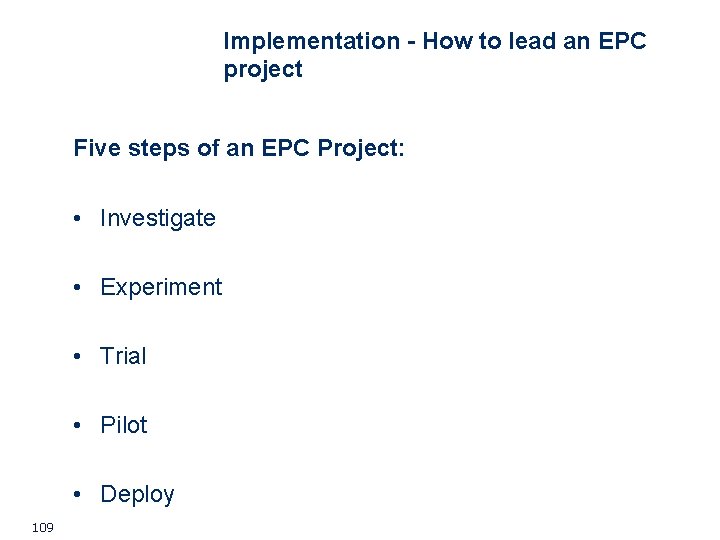
Implementation - How to lead an EPC project Five steps of an EPC Project: • Investigate • Experiment • Trial • Pilot • Deploy 109
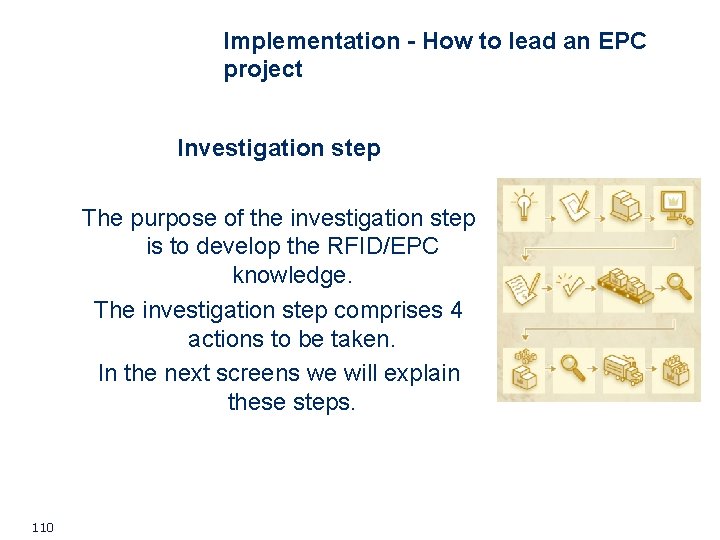
Implementation - How to lead an EPC project Investigation step The purpose of the investigation step is to develop the RFID/EPC knowledge. The investigation step comprises 4 actions to be taken. In the next screens we will explain these steps. 110

Implementation - How to lead an EPC project Investigation step • Learn the technology • Understand the business drivers • Secure sponsorship and funding • Identify the relevant use cases • Learn about the available resources 111
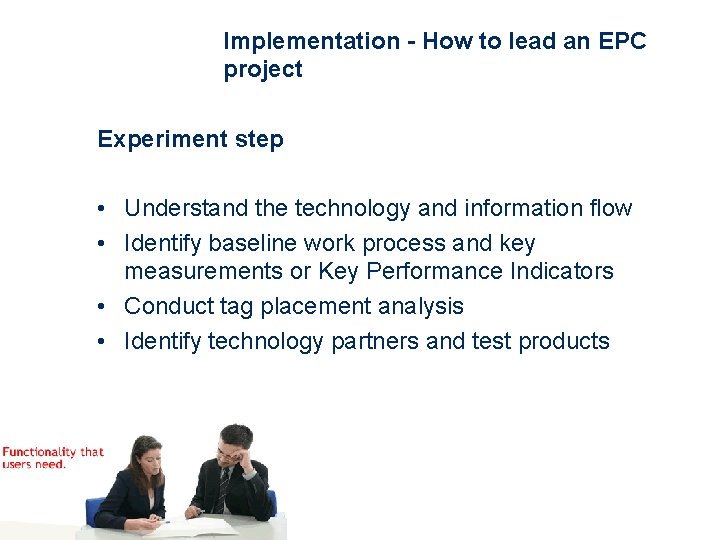
Implementation - How to lead an EPC project Experiment step • Understand the technology and information flow • Identify baseline work process and key measurements or Key Performance Indicators • Conduct tag placement analysis • Identify technology partners and test products 112

Implementation - How to lead an EPC project Trial step • Define and map the supply chain processes and examine process and environmental related issues • Document EPC/RFID impacts to business processes and define testing success criteria • EPC system/data architecture and the EPC numbering scheme and obtain EPC manager numbers • Identify cost drivers and develop communication plan 113

Implementation - How to lead an EPC project Pilot step • Verify the adoption strategy and cost items • Decide which EPC reading to be added • Analyse the in-process data and validate performance • Coordinate testing with trading partners 114
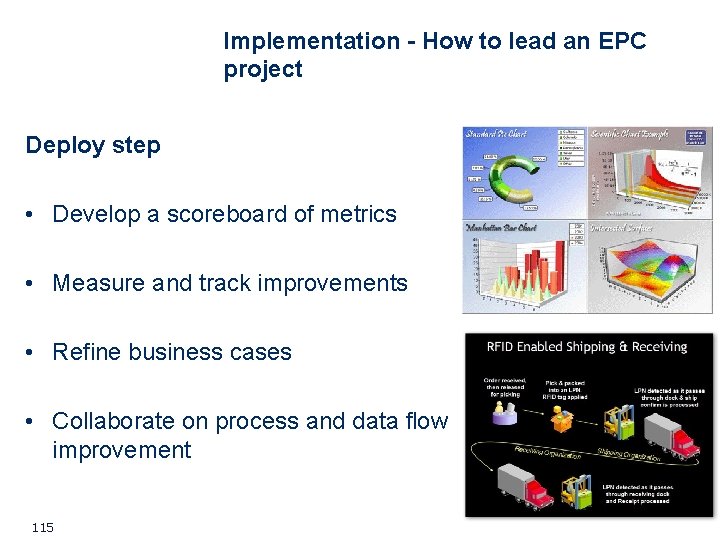
Implementation - How to lead an EPC project Deploy step • Develop a scoreboard of metrics • Measure and track improvements • Refine business cases • Collaborate on process and data flow improvement 115

SUMMARY Implementing an EPC project • • • 116 Investigate Experiment Trial Pilot Deploy
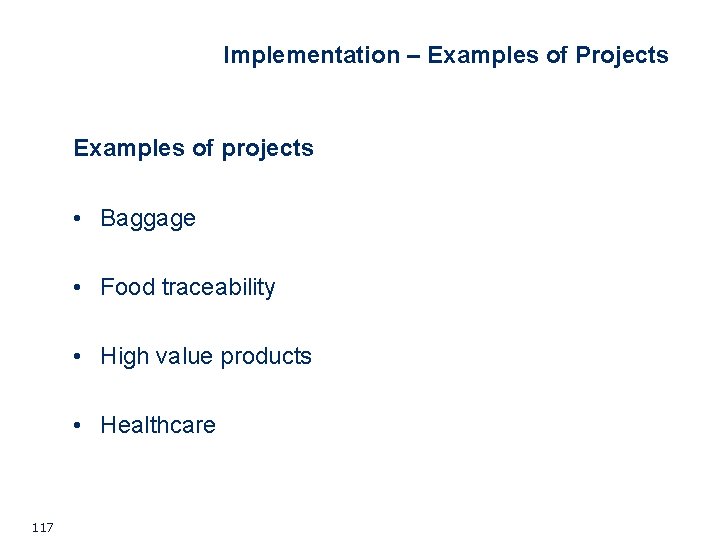
Implementation – Examples of Projects Examples of projects • Baggage • Food traceability • High value products • Healthcare 117

Implementation - Examples of Projects Hong Kong international airport System to tag and read tags on luggage. 17 million items are tagged yearly. The primary objectives: -improve operational efficiency -improve customer service. On average, a lost bag costs $ 100. Currently 2 per cent of all baggage is lost each year. The system directs the right piece of luggage to the right direction automatically instead of manually. A RFID label is attached to the regular baggage label and is read on conveyor lines. 118

Implementation - Examples of Projects Food traceability The Ministry of Agriculture in Japan has developed a project to tag fruit and vegetables. Primary objectives: - to ascertain the country of origin of the products - to trace the items that are coming from contaminated regions. 119
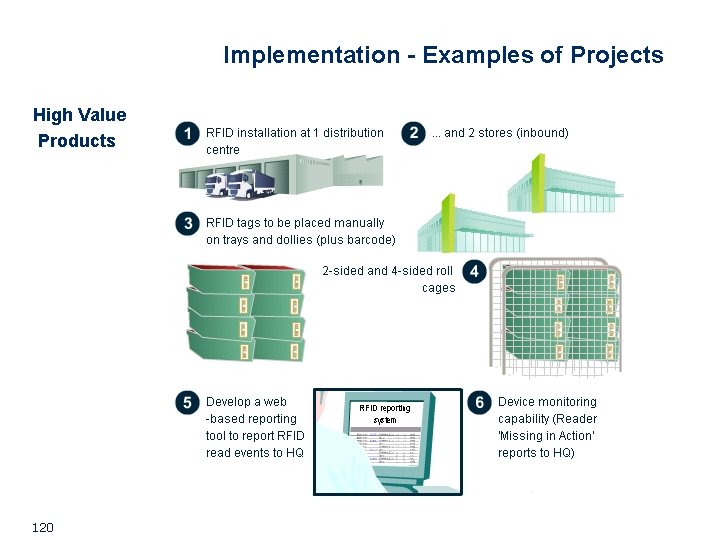
Implementation - Examples of Projects High Value Products 120
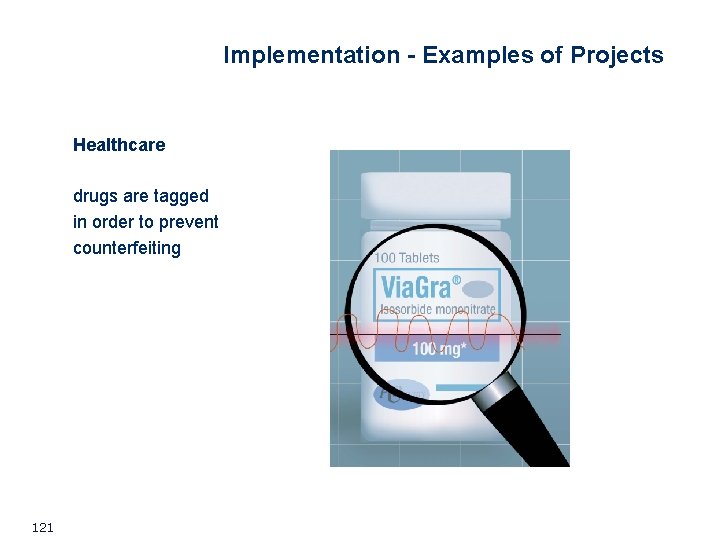
Implementation - Examples of Projects Healthcare drugs are tagged in order to prevent counterfeiting 121
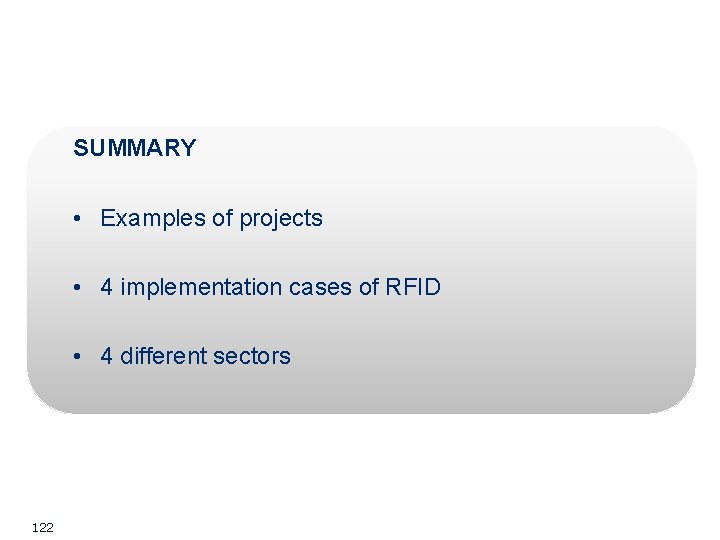
SUMMARY • Examples of projects • 4 implementation cases of RFID • 4 different sectors 122
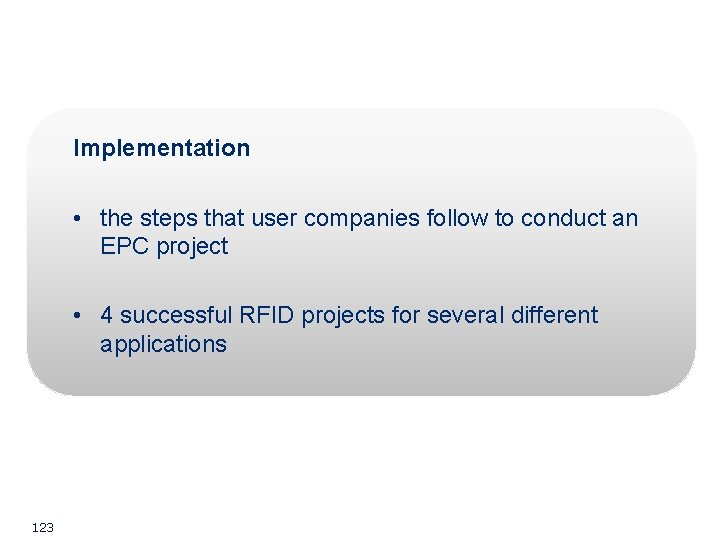
Implementation • the steps that user companies follow to conduct an EPC project • 4 successful RFID projects for several different applications 123
- Slides: 123